I’ve reviewed many air quality monitors on this site, yet despite being one of the most dangerous gasses out there, I’ve never discussed monitors for carbon monoxide (CO). While some indoor air pollution monitors, such as the uHoo, can detect this potentially lethal gas, they aren’t designed to be used primarily as carbon monoxide detectors and aren’t certified for this purpose.
Today, I want to examine the first carbon monoxide detector I’ve looked at on this website – the SA103 CO Detector from GZAIR. This carbon monoxide detector is a small, pill-shaped product designed to be easily slipped into a pocket or backpack and taken everywhere with you. This makes the SA103 a unique CO detector, as carbon monoxide detectors usually find themselves in similar situations as fire detectors, typically mounted to the roof or wall in houses.
However, this limits their usability substantially. While having a carbon monoxide detector in your home is extremely useful and potentially lifesaving, there are other times when carbon monoxide is more likely to impact us. For example, if you camp regularly, you likely expose yourself to some carbon monoxide every time you cook – especially if you rely on a gas stove.
Furthermore, you may not realise it, but we regularly breathe in small concentrations of this particularly harmful gas throughout our day-to-day lives. If you regularly walk or bike along busy roads or highways, you might inhale this toxic chemical without realising it. As you’ll find out later in this article, I was quite surprised, but the concentrations of CO near roads are surprisingly high!
Therefore, a portable carbon monoxide detector such as the GZAIR SA103 can come in handy in various situations as it is a device that allows you to safeguard not only your health but also the health of your family and friends. For this reason, I am excited to present my review of the first CO monitor I’ve reviewed on this blog, the SA103 CO Detector.
Suppose you’re a regular camper looking for a home-based monitor that can be moved when needed or want to carry a monitor around to investigate the carbon monoxide concentrations in different areas. In that case, this might be the perfect monitor for you. Read on to see whether it lives up to expectations, or you’re better off investing in a different monitor.
This post contains affiliate links. For more information, please refer to my affiliate disclaimer. I was sent a product for review, but the article is not sponsored. All opinions expressed in this post are my honest thoughts. I only recommend products that I genuinely believe in.
Information on this blog is for informational purposes only. Readers are encouraged to confirm the information herein with other sources. Furthermore, this information is not intended to replace medical advice from professionals. This website assumes no responsibility for the accuracy of the information, and information is subject to change without notice. Devices mentioned on this website are not medical devices and do not guarantee protection.
Accuracy and Sensor
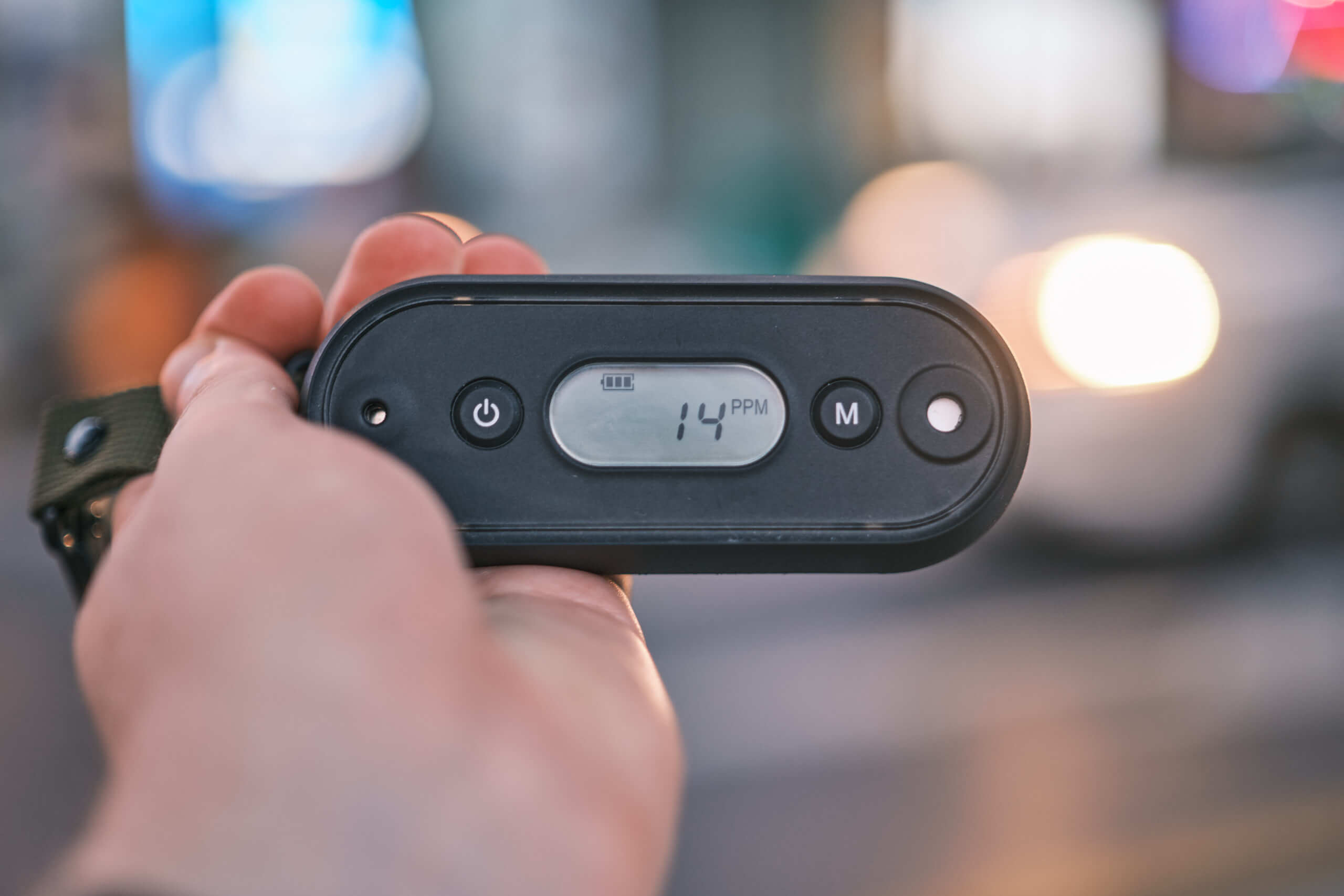
Regarding carbon monoxide sensors, the most critical question is whether the monitor is accurate. However, before we get to that, we need to look at the standards (or lack thereof) to which the GZAIR SA103 CO Detector has been tested.
GZAIR provided me with a range of certificates showing the third-party test results for the SA103. Most notable among these certificates was the UL 2034 certificate, which confirms the device complies with the requirements set by the standard. Shenzen CTL Testing Technology Co., LTD carried out this testing.
But what is the UL 2034 standard? Created by UL Standards & Engagement (ULSE), the UL 2034 standard was created to set a baseline and requirements for carbon monoxide alarms used in living spaces. According to UL, these include inside recreational vehicles, mobile homes and recreational boats with enclosed accommodation and cockpit areas. For more information on the standard, you can refer to this link.
The device also has other certifications and holds the CE mark, but these aren’t pertinent to this section as this testing was carried out to identify the product’s performance concerning the electromagnetic compatibility of multimedia equipment (MME). Therefore, these certificates and test results aren’t as necessary to discuss in this section of the article.
The U.S. EPA (Environmental Protection Agency) recommends that every house have at least one UL 2034 or International Approval Services 6-96 standard approved CO monitor. This shows that these two standards carry a lot of trust, and you should only be using carbon monoxide monitors that are certified with these standards. Luckily, the SA103 has undergone UL 2034 testing and complies with the requirements.
With that said, the SA103 is not ideal as a home-based monitor. While it does meet the applicable requirements, the EPA recommends having a CO detector outside every bedroom, and purchasing this many SA103s is very costly. Instead, I would recommend investing in other UL 2034-approved CO monitors for your home and having the SA103 as a portable monitor for use where and when needed.
So, is it accurate? The UL 2034 standard compliance shows that the GZAIR SA103 is indeed accurate. However, I was also curious to do some of my own testing on the device. Unlike many CO monitors, the SA103 has a screen which shows the exact CO concentration. This is dissimilar to most CO products, which instead have a threshold over which they will alert the user.
While I lack the tools to test the accuracy formally, my research and testing also point to the device as accurate. You will find a CO sensor from the Japanese sensor company Nemoto inside the device. This sensor is an electrochemical sensor that detects CO levels with a resolution of 1ppm between 0-1,000ppm. Considering that longer exposures to even 200 ppm can be lethal, and short exposures to 800 ppm are quickly fatal, this range is well-suited to any situation the device might be exposed to.
While different types of sensors are used to detect carbon monoxide, NIST points to all these common types (electrochemical, metal oxide and opto-chemical) of carbon monoxide sensors as significantly reducing your chances of carbon monoxide poisoning.
Electrochemical sensors also have a few other advantages that can lead to them potentially being more accurate. For example, they can have selective filters placed before them to remove other gases that could potentially cause false positives. Furthermore, these sensors have broader applications due to being operable in more conditions while drawing less power.
While I am unable to test the exact accuracy of the SA103 myself, Nemoto, the brand that makes the CO sensor within the device, has a reputation for high-quality sensors, and they’re used in many products, including many other carbon monoxide monitors that you can find on the market.
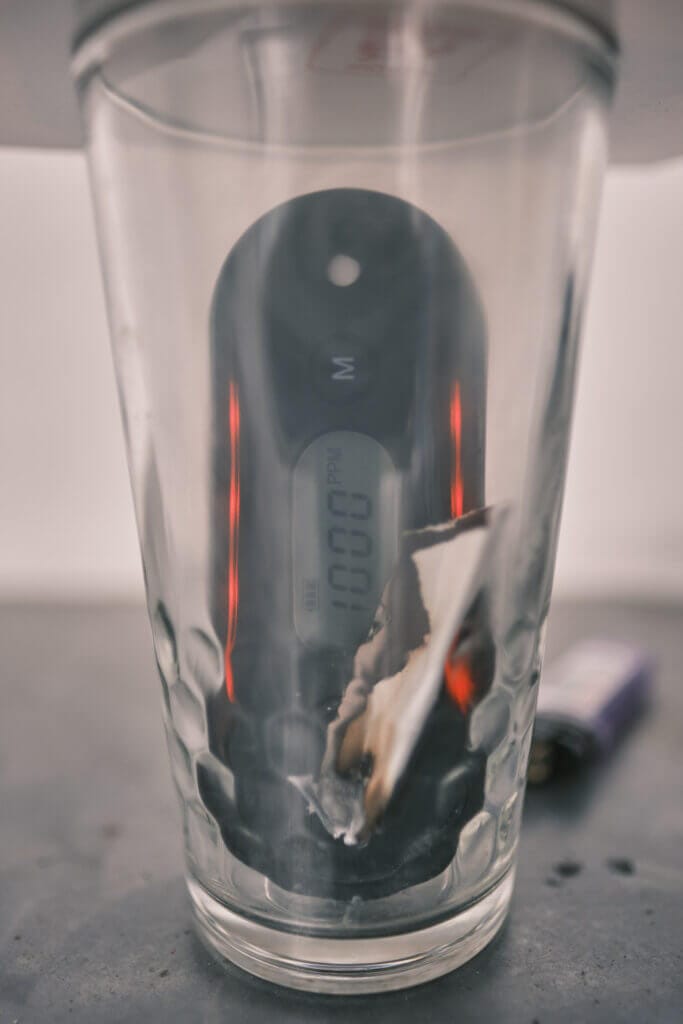
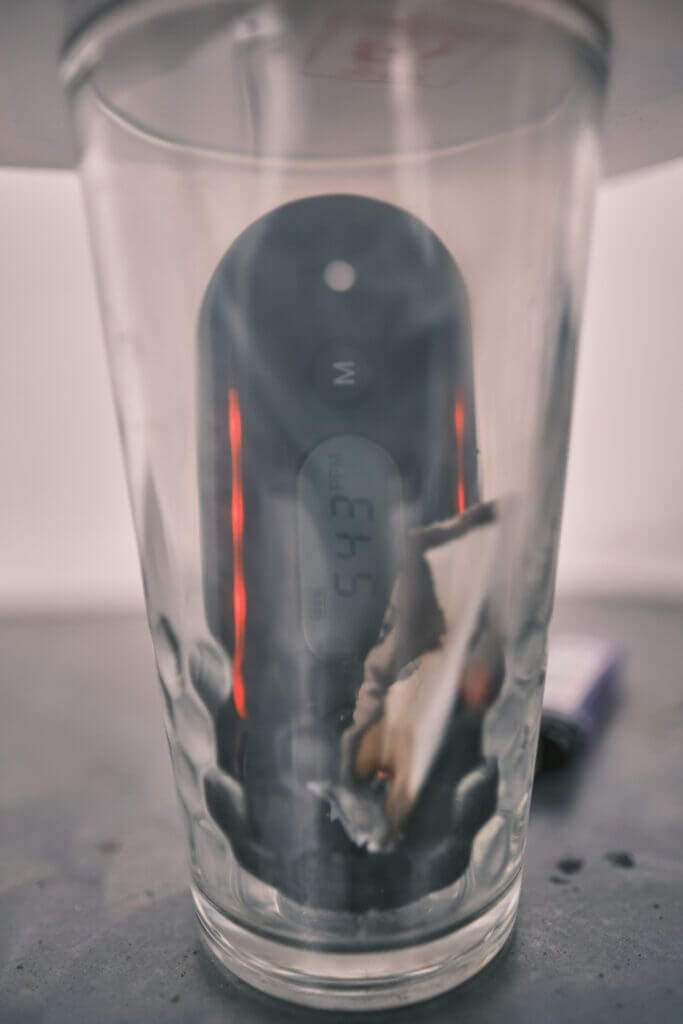
Testing the device inside a sealed glass with a smoking piece of paper.
While I couldn’t do precise tests, I was curious how the monitor would read in several settings, so I set up a few simple tests. For the first and most ‘blunt-force’ test, I stuck the monitor in a pot with a smoking match. I put the lid on the pot, and after about seven seconds, the monitor started beeping, indicating a CO concentration of above 50 ppm. A further couple of seconds later, the device vibrated, indicating a concentration above 100 ppm.
After around 20 seconds, the device read over 300 ppm, and I removed it from the pot. The reading slowly decreased over the next minute or two before settling at 17 ppm. At first, I was worried the device was faulty, but this turned out to be sensor drift, which can sometimes happen to CO monitors.
I asked the GZAIR team, and they mentioned that while the device should normally zero itself, if it doesn’t, you can force the device to zero itself by pressing the power button and M button simultaneously for a few seconds. This will reset the device to 0 ppm.
Since the device recalibrates every time you turn it on, you can also power the device off and then on. However, this process takes a few minutes and isn’t essential as you can just zero the device using this method instead.
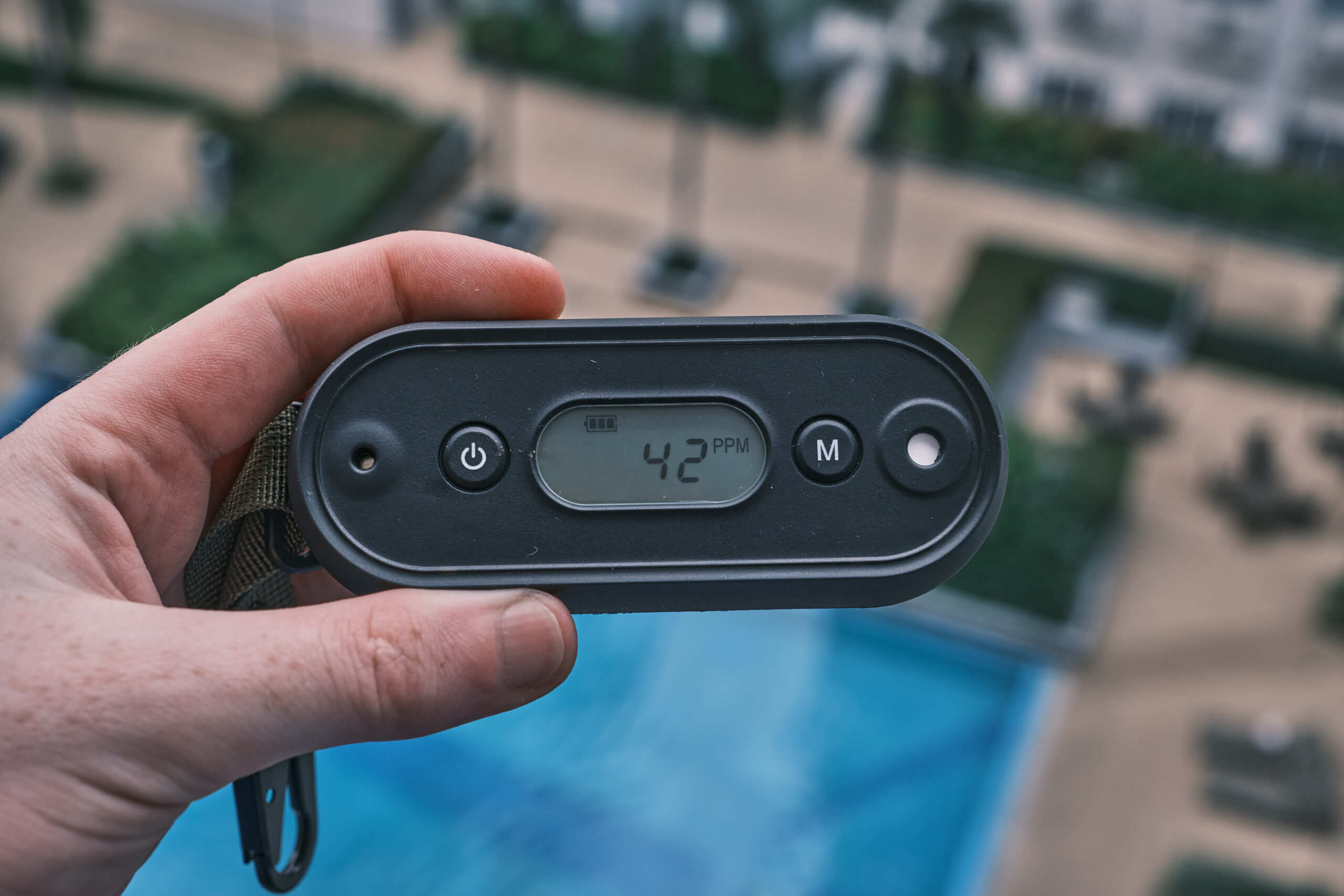
Even in clean air, the device won’t reset to 0 ppm. To remedy this issue, you will need to reset the device so it can calibrated again (which happens every time you power on the device).
In the second test, I took the SA103 into a busy underground parking garage. Here, I expected to see a minor concentration of carbon monoxide from vehicle exhaust. I was not disappointed; after some cars passed, I saw the reading jump to 12 ppm. Considering that 9-10 ppm is the eight-hour exposure guideline from the WHO, this was an interesting finding.
Once I moved to a less busy section of the parking lot, the concentrations dropped to 2-4 ppm. After concluding that the device was working, I left the parking lot and reset it again, as it wouldn’t drop below one part per million even when I was in known clean air.
The final test was to use the SA103 near a gas stove. Since the device is targeted towards campers, I felt this was a good test for the device. After all, the only time you’re likely to be exposed to CO when camping is when it comes to cooking – especially if the weather is terrible and you need to cook inside your shelter.
During the 30 minutes I was cooking dinner, the device peaked at 28 ppm. This surprised me as I didn’t expect it to get anywhere near that high! However, after I opened the windows and improved ventilation, this value quickly dropped until it, once again, settled at around 3ppm.

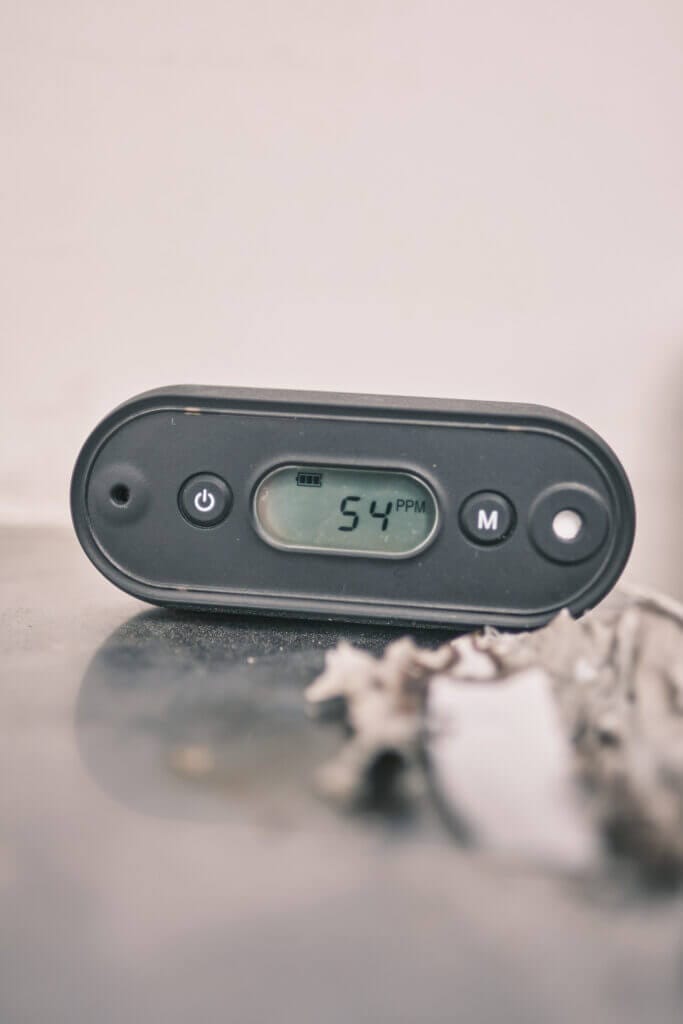
Carbon monoxide concentration next to a burning piece of paper (in outdoor air).
After running these tests, I can conclude that the SA103 can identify carbon monoxide and is accurate enough to be useful. While I can’t test the exact accuracy as a controlled environment and reference gas would be needed, the device seems accurate enough to be used in the situations that it’s targeted towards.
However, there is one final note to make here. CO sensors have maximum lifespans, and they will eventually lose accuracy and, therefore, need to be replaced. The SA103 has a five-year lifespan and should be replaced once this limit is reached.
Usage Cases

Although I’ve already addressed a few use cases for the SA103 carbon monoxide detector in the introduction, it’s worth looking at them in more detail. After all, why would you even want to purchase a portable carbon monoxide detector? Let’s discuss that.
Now, the first use case for a carbon monoxide detector is, of course, at home. While home-based CO monitors are usually wall or ceiling-mounted, CO is slightly lighter than air and tends to disperse evenly, meaning that a monitor such as the SA103 sat on top of a set of draws or a shelf can also work as a home monitor.
Carbon monoxide hospitalises 50,000 people per year and kills just over 400 in the U.S. alone, showing how beneficial it can be to have a carbon monoxide monitor in your home. That said, I wouldn’t recommend the SA103 primarily for this purpose, as it’s more expensive than many other CO monitors.
Instead, the SA103 excels if you need a portable monitor. For example, if you regularly take the monitor out with you, it’s a good purchase. Of course, when you’re not taking the monitor out and about, it can be used at home. However, primarily, using this as a home-based monitor is both pricey and not ideal.

So why would you take this monitor out and about with you? Well, I can think of two key reasons. First, you like camping and regularly use open-air fires or gas-powered cooking equipment. In either of these cases, carbon monoxide can be trapped in your tent or sleeping area, potentially causing significant danger.
In these situations, having a carbon monoxide monitor that you can take with you is potentially life-saving. Since the monitor is also water-resistant, dust-proof, and shock-resistant (it’s IP67 and also drop-proof for up to 20 feet), it’s perfect for this situation as you can easily put it in a backpack without worrying.
Another situation where I can see the usefulness of a carbon monoxide detector is the situation in which I’ve been using the monitor for the past few weeks. As a digital nomad, I usually stay in hotels or apartments, and I have no control over the air quality or whether or not a carbon monoxide monitor is present.
A small, portable CO Detector such as the SA103 is perfect in this case. I can easily put it anywhere in the room or apartment I am staying in, and since it’s battery-powered, it can be placed anywhere. In these situations, it’s perfect because it takes up barely any space but allows me to keep an eye on potentially dangerous levels of carbon monoxide.
If you are a frequent traveller, a camper, or even someone who regularly has indoor fires in a wood burner, a carbon monoxide detector such as the SA103 from GZAIR could be the perfect companion to ensure the air you breathe is clean and safe.
Design
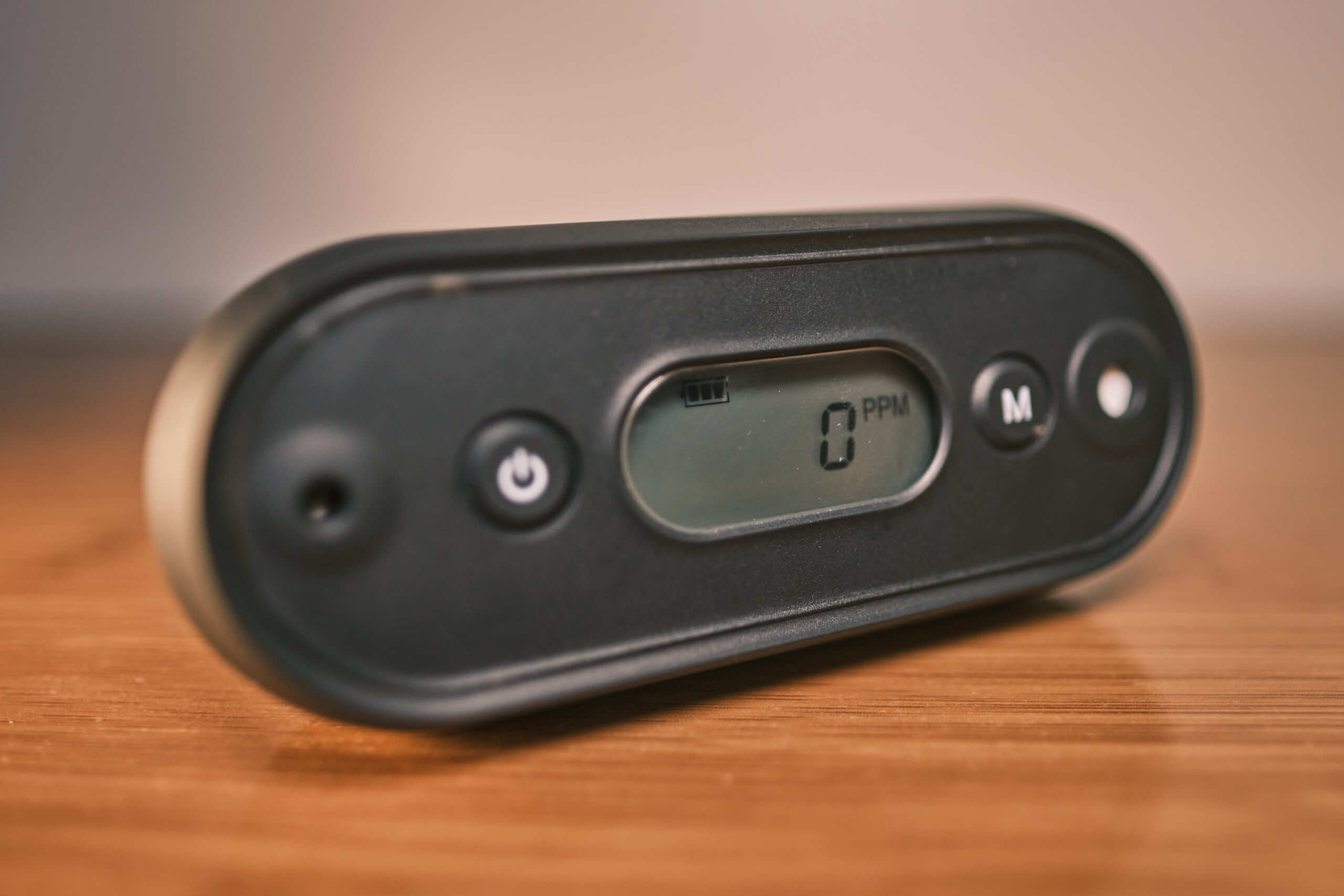
The design of the SA103 CO Detector is what separates it from many other monitors on the market. The SA103 has been designed from the ground up to be portable, and not just portable but also rugged.
Let’s get some critical specs out of the way first. The SA103 from GZAIR is certified IP67, meaning it is dust-tight and water-tight – at least in water up to 1 meter deep for 30 minutes. Below are the definitions on Wikipedia for IP67.
Wikipedia definitions:
- IP(6)7: No ingress of dust; complete protection against contact (dust-tight). A vacuum must be applied. Test duration of up to 8 hours based on airflow.
- IP6(7): Ingress of water in harmful quantity shall not be possible when the enclosure is immersed in water under defined conditions of pressure and time (up to 1 meter (3 ft 3 in) of submersion).
These specifications show that the SA103 is intended to be taken outside and is primarily aimed at campers and those in other situations where the conditions can’t be controlled. While it isn’t waterproof, it should be able to withstand all rain and rain, and even getting wet shouldn’t impact the device or the readings it takes.
On top of the IP67 rating given to the SA103, it is drop-resistant for up to 20 feet (6 metres), which makes it one tough product. While it shouldn’t be thrown or purposefully treated roughly, it should be more than capable of surviving accidental drops – even if dropped into a puddle.
I imagine these specifications explain the seemingly odd shape of the SA103. While a pill shape might seem strange at first, it makes a lot more sense once you realise that the rounded corners and extended ends likely exist to buffer the components inside if the device is dropped.

On the front of the device, we have two buttons, a screen, and two ingress points. On the left-most of the device is the hole that contains the speaker. This device is designed to alarm the user when the CO concentration surpasses 50ppm, and it will also vibrate when the parts per million of CO surpass 200ppm.
On the other end of the device is a covered hole behind which the electrochemical sensor sits. This is how ambient air enters the device, and after air passes through this hole, it will be exposed to the sensor, which will identify the current concentration of carbon monoxide.
Bordering the screen are the only two buttons on the device. On the left of the screen is the power button with a self-explanatory function – to turn the device on and off. While the button itself is pretty straightforward, there are two things to note here.
Firstly, when turning on the device, it will take around 90 seconds to calibrate itself before it starts giving measurements. During these 90 seconds, you won’t be able to take any measurements and will need to wait for the boot sequence to finish before using the device.
Secondly, since the device calibrates every time you turn it on, you want to ensure you turn it on only in environments with no CO present. Obviously, this isn’t ideal, as how can you be sure you’re CO-free when your monitor is off? Thankfully, this is quite easily solved by going outdoors while the monitor finishes its boot cycle.
Since the monitor has great battery life (I’ve had it for around one month, and it is still at three bars), it’s easy to prepare in advance. If you are going for a camping trip, take the monitor and calibrate it outside before even setting off. This will easily last you for months without turning off the device!
The other button that flanks the screen is the M button. This is the button you will usually use to interact with the device, allowing you to alternate between the CO measurement screen, the time, and the ‘M’ screen. This screen will show the maximum CO concentration the device has recently been exposed to.
This brings us to the screen itself. Well, like the rest of the device, this is quite simple, and depending on the mode you’re in, it will show you either the current CO concentration, max CO value, or time. Alongside these readings, you will also see the battery life represented by a battery icon in the top left of the screen.
Although you can’t see them until the alarm goes off, the top and bottom borders of the front panel had a red LED strip hidden behind them. At 50 ppm, these lights will start to flash, meaning this device has three alarm modes – visual, audible, and tactile.
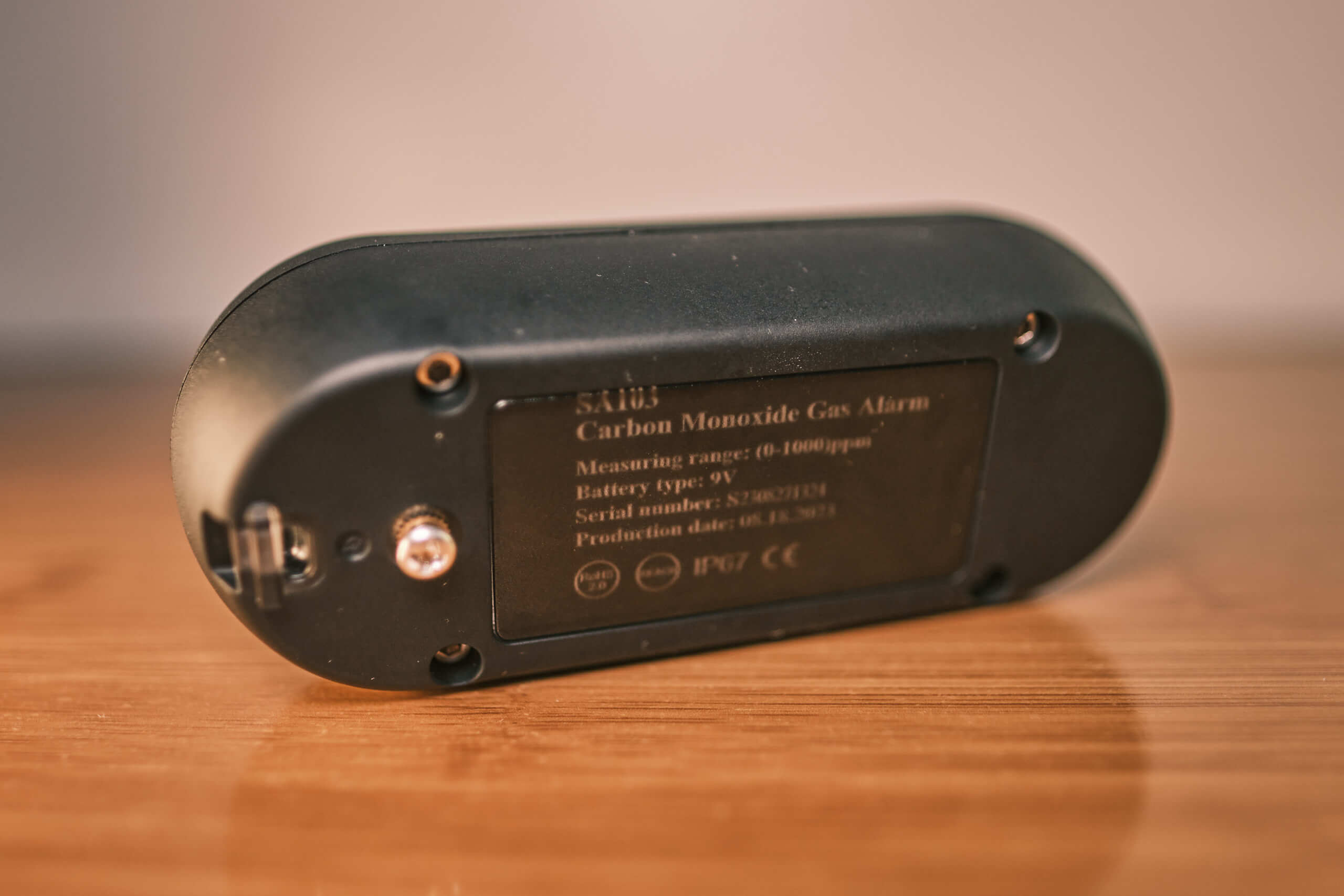
The sides of the device have nothing of note other than rounded and pill-shaped. As mentioned previously, this is likely to ensure the device is drop-resistant, as having rounded corners means the device will not have as great of an impact if dropped, and it allows the components inside to be protected.
The only other design features worth noting are on the back of the device. Here, you will find two kinds of lanyard mounts. There is a screw that can be used to attach the included lanyard and a point where you can pass through a string if you intend to use a different lanyard with the device.
You will also find four screws here which are pentagon-shaped. To replace the battery, you will need to remove these screws to remove the back panel. While I wish the screws were a more common type, it’s nice that the battery can be replaced as the device has an expected lifespan of five years, whereas the battery life is expected to be only around two years.
Overall, the design of the SA103 CO Detector is simple yet functional. The device is clearly designed to be functional first, allowing GZAIR to ensure it’s both portable and strong. While it’s not ideal as a home monitor since it has no mounting points, it’s great as a portable device.
Conclusion
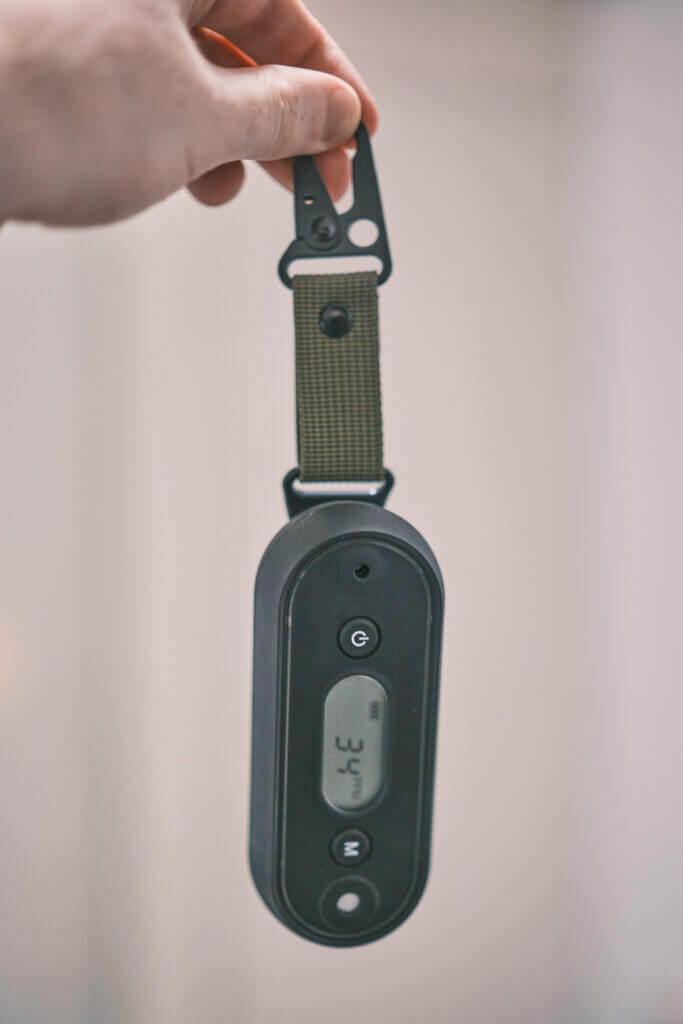
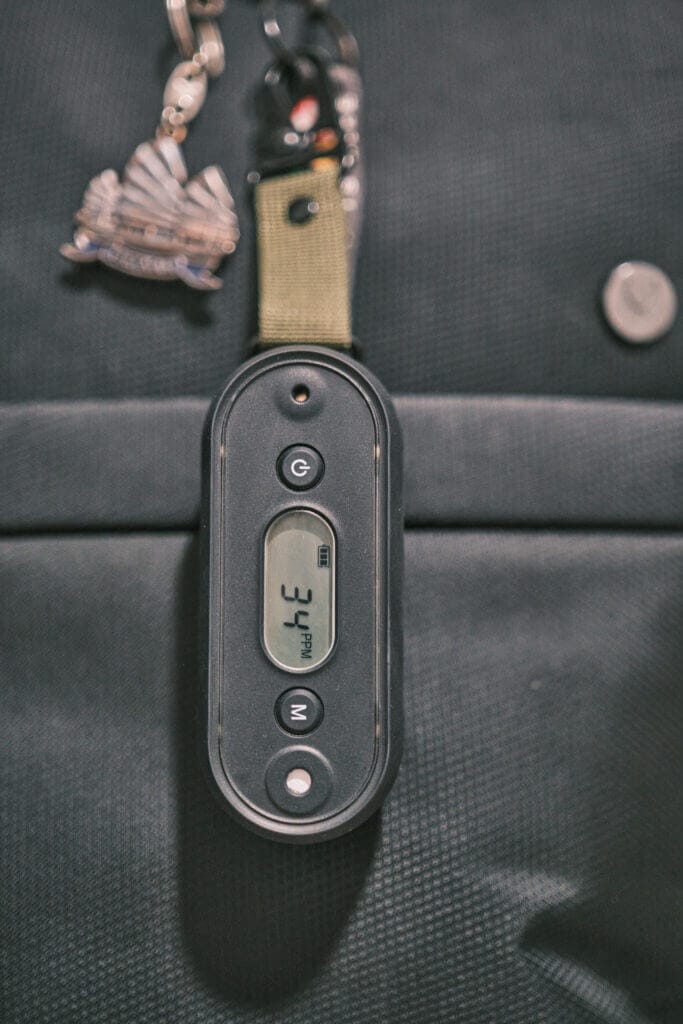
Is the GZAIR SA103 worth it? Well, I think this depends on your answer to one fundamental question: do you need or consider a portable carbon monoxide monitor to be helpful? If the answer is yes, then the SA103 might be perfect for you.
What I appreciate the most about this device is that it’s set and forget. While this might not seem like a compliment, I personally prefer a device that does its job, and I can forget about it. At the same time, if I’m ever in danger, this device will quickly let me know. In that way, it’s perfect – the battery life is excellent, the device is accurate, and I don’t need to ‘baby’ it because I know it can handle travelling.
If you’re looking for a primarily home-based monitor, there are better options. Namely, devices that are wall/ceiling mountable and significantly more affordable. On the other hand, if you need a device you can take virtually anywhere, the SA103 is perfect.
In my case, I appreciate this device because I am a digital nomad, and most of the hotels and apartments that I live in don’t have CO monitors. While I haven’t yet needed this device, I always feel reassured knowing it’s there to alert me if a room or apartment unknowingly becomes toxic.
People who regularly go camping or live in campervans could also find this device useful. Open-air fires generate a lot of carbon monoxide, and if the gas enters your tent or lodging, it can quickly impact your health. For anyone in either of these situations, the SA103 is a handy device.
Of course, there are a range of other situations in which a device like this could be helpful. For example, if you regularly like working in the garage on cars, having a device like this can let you know when you need better ventilation to decrease the level of toxic car exhaust in the area. While this is just one situation I can think of off the top of my head, there are many such situations where a device like this could be handy.
GZAIR SA103 FAQ
Is the SA103 Accurate?
Yes. The SA103 is accurate due to the Japanese-made Nemoto electrochemical sensor within. It also complies with UL 2034.
What Is the GZAIR SA103?
The SA103 is a portable carbon monoxide detector.
Is Carbon Monoxide Dangerous?
Yes. Even exposure to low concentrations (80 ppm) can prove lethal after a few hours.
Does the SA103 Detect Anything Else?
No. The SA103 only monitors CO.
Do I Need a Carbon Monoxide Detector?
Every house should have at least one carbon monoxide detector. However, whether you need a portable one depends on if you are a regular camper or are commonly in environments where CO is common.
Have Questions or Comments?
Join the discussion on the BreatheSafeAir Community Forum. Ask any questions you have about air quality or adjacent topics and get quick answers!
GZAIR SA103

Today, I want to examine the first carbon monoxide detector I've looked at on this website - the SA103 CO Detector from GZAIR. This carbon monoxide detector is a small, pill-shaped product designed to be easily slipped into a pocket or backpack and taken everywhere with you. This makes the SA103 a unique CO detector, as carbon monoxide detectors usually find themselves in similar situations as fire detectors, typically mounted to the roof or wall in houses.
Product Brand: GZAIR
4
Pros
- IP67 dust and water resistant
- Shock-proof
- Exceptionally easy to use
- Long battery life
- Long sensor life
- Included carabiner
- Complies with UL 2034
Cons
- Relatively pricey
- Still quite large